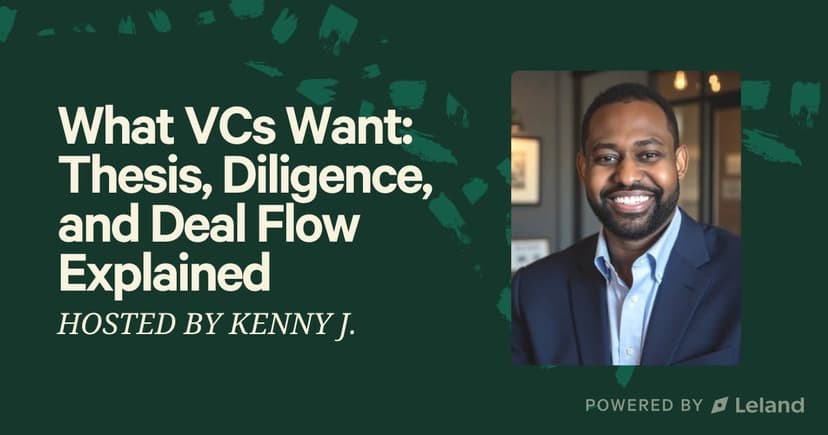How to Get Into Venture Capital: Lessons Learned Interviewing 100+ Investors
A partner at a top venture firm outlines the VC hiring process, what makes the best candidates stand out, and more in this insightful article.
Posted October 25, 2025

Join a free event
Learn from top coaches and industry experts in live, interactive sessions you can join for free.
Table of Contents
The venture capital career is known for attracting a broad cast of characters. Before becoming some of the most iconic investors of their generation, Marc Andreessen invented the web browser, Mike Moritz started out as a journalist, and Bill Gurley worked in equity research. In fact, my colleague at Contrary Jason Chen studied 20th-century literature and romantic poetry before starting a company and becoming an investor. Not much of a pattern there.
This is equally true for more junior roles. In the hundreds of interviews I’ve conducted over the past few years, I’ve met a broad swath of candidates who started companies, worked at startups, or had product, consulting, and engineering roles. While the backgrounds are different, there are a number of similarities between those who are ultimately successful in an interview process and a role.
Ultimately, everyone with a fruitful career in venture carves their own path. In support of this pursuit, I’ll outline Contrary’s hiring process and provide advice for everyone considering a job in venture.
The Hiring Process
Most surprising to people I talk to is the brevity of our optimal process. For junior-level investing roles, we don’t require much venture experience, so we simply look for raw potential. This may seem counterintuitive, but those who are open to a junior role with 3+ years in venture are either 1) too committed to their current firm as they just start to build a track record, 2) haven’t progressed into more senior roles for a reason, or 3) out of our price range as a star investor.
This means we consider a wide variety of profiles with a focus on identifying future winners. After posting a new role, we take a three-pronged approach to building our top-of-funnel:
- Inbound: We post the role on social media and typically get hundreds of cold emails. We don’t have conversations with most people who reach out this way because of fit problems, but we have had success with this channel.
- Outbound: We identify experiences and skills that are relevant to the role (e.g. do you work at a similar firm) and reach out to people individually. This has a lower conversion rate than inbound since there’s no candidate intent, but conversations are highly relevant.
- Referrals: We solicit our personal networks for recs. This is most useful for finding people that are not currently involved in venture, but are interested in becoming so.
Once we fill our candidate funnel, we start having conversations. We don’t care about how we find someone. While each channel has its own trade-offs, they all feed into the same pool. There are generally three steps to our interview process, which I’ve outlined below.
Intro Call
We schedule a 20-30 minute intro call to meet each other, test basic fit, and pitch candidates on the role.
This is meant to be an open conversation. My intention is to feel out why a candidate is interested in Contrary and qualitatively understand their personality and experiences. I ask questions such as:
- What’s your story?
- Why venture?
- What do you know about Contrary?
We tend to require a basic level of technical or operational understanding and the ability to personally relate to founders, energy, and breadth of interest across different spaces. The honest truth is that the vast majority of candidates can be filtered out in 5-10 minutes as imperfect fits. We may have a more stringent process than is typical, though, since the junior investors on our team have high responsibility and are GP-track by default.
Pitch Deck Review
With candidates who seem to have strong ops/founder experience and basic context on venture, and who seem to relate well to entrepreneurs, we sit down for an analytical pitch deck review session.
We ask candidates to walk us through what they think about each deck. What do you think of this space? What about the traction? The business model?
Over the years, we’ve found that quantitative analysis is less important, particularly for early-stage roles. The history of venture is littered with founders creating large markets that were previously unattractive or non-existent, for example. In our own portfolio, the best investments we’ve made often involved “next-level” individuals building something very special in what appears to be an otherwise difficult or small space. Indexing for this is all we care about.
We look for a nuanced and crisp articulation of each company and each market. If a candidate is aware of how precisely a given business model can be easy or challenging to scale, for example, that’s a great sign. If they only have a bird's-eye view of how an enterprise SaaS company would think about growth channels, though, we’d want to dig deeper with them.
This is critical for a reason beyond the decision-making: the best founders choose their investors. Asking stunningly insightful questions is one of the best ways to build rapport with the people we ultimately end up working with.
Meet the Team & References
The final step is rather straightforward. We want each hire to be a “YES!” about Contrary as much as we’re a “YES!” about them. So, we have the candidate meet the rest of the team, get to know them more personally, etc.
We’re not doing much evaluation at this stage, as much as further communicating our culture and expectations, and making sure everyone is completely aligned.
What the Best Candidates Do
So, what specifically can one do to prepare themselves for a career in venture and execute an interview process? There are a number of dimensions here, which I’ll touch on in no particular order.
Building “Context”
Semil Shah said it better than I could in his post The One Ingredient Required To Get Into Venture Capital:
“My belief is that in the VC game, having “context” means possessing the following: You have a network; you hold a point of view on a few topics that matter to you; that other people seek you out for help and advice; you have some understanding as to how the ecosystem’s participants — the founders, the early employees, the “joiners,” the operators, the angels, the investors, and the press — interact in the game. I believe if you show up in VC without these points of context, you won’t be as effective or be able to compete.”
Ok, so then, how does one go out and obtain this “context” you speak of?
“This is the best part. Context is everywhere around us. It’s free. In many cases, folks will pay YOU to obtain it, especially in the Bay Area. You can obtain context by being a journalist or reporter; by working at a technology company; by working for the corporate development or similar arm of an incumbent company. Context is a two-way street, though. You don’t just “get” context delivered to you. You have to go and get it.”
These days, context is as easy to find as ever. Semil’s blog has a bunch of great content, for example. Twitter is overflowing with venture content (much of it terrible, some excellent). There are too many YouTube talks and podcasts for one individual to consume. It sounds quite simple when it’s written out, but the vast majority of candidates I come across should spend more time reading the “venture canon.”
Building a Coalition
Most firms do not expect hires to come with a deep network of operators, founders, etc. In fact, the apprenticeship culture of venture is well suited for taking people with raw talent and plugging them into the infrastructure needed to operate the firm. The leadership can handle LP, GP, and founder relationships to start, and slowly hand off more and more responsibility as skills are built.
That said, we tend to expect hires to have a “coalition” of friends around them who drive learning and network power. Candidates that have a coalition of venture/startup friends around them are most likely to build a coalition of investable founders when taking a venture role.
This can come in many forms. Perhaps a candidate studied computer science in college and has a deep roster of friends that can be asked for technical advice. Or maybe somebody has sent out research articles to VCs that map a market for them.
One investor I know started out in academia, working on a well-known, cutting-edge biotech initiative. After quitting academia, he typed up research on healthcare startup opportunities and cold emailed it to investors. He then became the go-to person that I’d send biotech deals to! From his perspective, the simple offer of, “Hey, I spent a bunch of time in this space, let me know if I can help you understand anything.” was enough to start building quality relationships with plenty of investors.
Work for Founders
Before becoming an investor, I spend many hours helping founder friends for fun. This was a great way to learn, support my friends, and also build street cred that would later prove useful when convincing entrepreneurs to work with me at Contrary.
There are many possibilities such as:
- Connect talented engineer friends with a startup looking for hires.
- Write blog posts about a space or specific company. Packy McCormick does a great job with this for example. Look up his explainer post on Ginkgo Bioworks.
- Put together a market map and analysis on a space and cold email investors. Offer to connect them to your friends conveniently located on said market map.
- Actually hack on product or growth projects!
The key here is that this should be 1) fun with friends, 2) an inherently worthwhile learning experience regardless of venture ambitions, and 3) something that can be done in free moments regardless of your personal situation. I started doing this in college on top of a brutal courseload when I didn’t have much money.
Blake Robbins (unrelated to me) did a wonderful job typing up his story which embodies this spirit.
Carve Out a Niche in the Craft
There is no formula for success in venture, but the “ingredients” are fairly straightforward. VCs must source great companies, make the right investment decisions, and use their own relationships or firm’s brand/platform to win the best deals. Missing any one of these three ingredients means you won’t invest in a great company.
Of course, few (if any) investors can do all of these on their own. I prefer talking to candidates who have a clear understanding of their strengths and shortcomings when it comes to the three-step dealmaking process. For junior roles at Contrary, for example, I want to have enough faith in someone’s decision-making and relationship-building ability that when they plug into the Contrary founder network, they’ll be able to use our platform’s advantages to compliment their own traits.
To elaborate, each of the three parts of the process have common “styles” of work.
- Sourcing: You can source by having a large social media following, a deep personal network, connectivity in one vertical, ability to just sniff out amazing people somehow, or talent for going outbound and reaching out to founders early.
- Decision-making: Some people are experienced in one space (e.g. fintech) such that they can make great decisions on their own. Some lean on a coalition of friends to outsource the tricky parts of diligence in unfamiliar spaces. Some have an excellent intuition for identifying founders so brilliant that they can be trusted to just figure it out and make something work.
- Winning deals: This is often the hardest part because of the adverse selection. Have a clear answer to “why is this founder taking money from me instead of Sequoia?” Often times the answer is that you have the best relationship with the founder themself. Or maybe you can help them with something specific that no other investors can. Typically firm brand and GP relationship is the biggest factor in each founder’s decision.
From my perspective interviewing candidates, I don’t care which path is taken for each of these components of the role. But being good or having clear potential at each, however you’re able to do that, is important.
Lessons Learned Over the Years
Given everything I’ve articulated above with respect to our process and what great candidates do, there are a number of things I wish I had done differently when hiring in years past.
Firstly, I wish that I had allocated more time to building relationships with excellent people in product, design, engineering, etc. than interviewing people who apply to the role. I found it quite challenging to figure out which operators might be interested in a venture role, even though they are often the best hires, so outbound was less successful than I’d hoped. I still worry that we’re not finding the hidden gems currently working at startups. Candidates in startup operator roles can find ways to better indicate their interests in investing one day, even if it’s a note on their LinkedIn profile or a blog post about companies they’d want to invest in.
Running an intense process quickly is the best way to hire. In the spirit of the Secretary Problem, I try to block off a full month to do nothing but hiring. By jamming 100+ interviews into 4 weeks, we can make decisions with as big a pool as possible. This emphasizes the need to “always be sourcing” and build relationships ahead of an interview month. Every VC will try to hire talented operators/founders in-network first, so it’s best to have some touchpoints ahead of time.
For a founder-facing role (especially on such a small team), we try to set the bar unreasonably high. In fact, there have been two instances where we make an offer to someone to join the Contrary investing team, only to get turned down and start a company that we end up investing in. While it’s never fun to lose a candidate you’re courting, I’m glad that we somehow find highly-capable builders to recruit in the first place.
Observing other firms hire, I’ve been surprised at how much brand matters in the hiring process. As someone who did not go to Stanford or work as a Product Manager at Stripe, I must warn you: most investors will jump to conclusions based on the brands on your resume. This is a highly unfortunate reality. But luckily, most candidates who have the credentials will have never done anything to prove their knowledge or ambition such as writing about venture capital. If you write even a single high-quality blog post and publish it on a personal website, you will be in the top 2% of candidates. It’s stunning how few people have put together this “proof of work” in any way. This makes it all the easier to stand out if you don’t have trendy brands on your LinkedIn profile. (Life hack: this seems to be true across all parts of life!)
In Conclusion
The venture world hires from a broad swath of profiles, and is also highly variable itself. Some roles are focused on hosting dinners and sourcing founders, some on market research, and some are all-in-one, sink-or-swim setups.
Everyone I know in the industry has a fairly unique history and trajectory. While this makes it hard to follow in others’ footsteps, I view it as empowering to forge your own future. Everything written here has been based on specific circumstances, and should only be taken as one perspective.
Go forth!
P.S. Interested in working with me on your application, networking strategy, or anything else related to Venture Capital? Book a free intro call on my profile to get started.
—
Here are several other articles you may find interesting:
- The Top 10 Venture Capital Fellowships
- The Best Venture Capital & Private Equity Newsletters and Podcasts to Subscribe To
- Top 10 Finance Mentors
- The 50 Most Common Venture Capital Interview Questions
- The Top 10 Venture Capital Books
Sign up for Leland to receive access to exclusive resources, a community of ambitious individuals, alerts for events and classes, and much more. We will help you get your dream venture capital job and accomplish other goals.
Browse hundreds of expert coaches
Leland coaches have helped thousands of people achieve their goals. A dedicated mentor can make all the difference.













